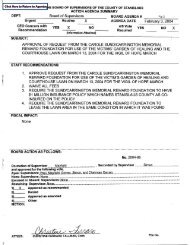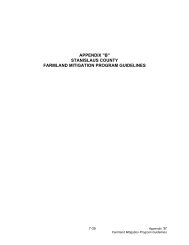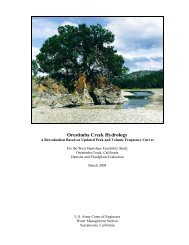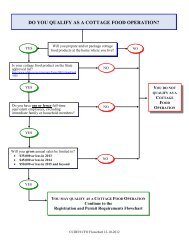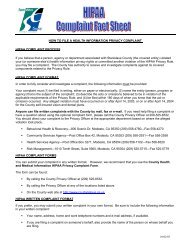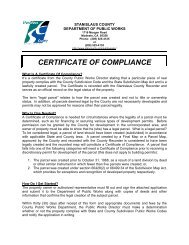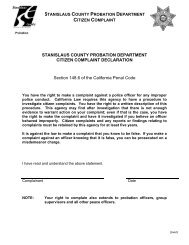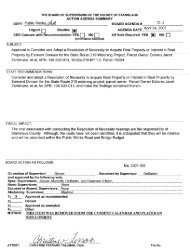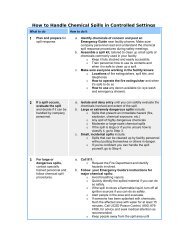Orestimba Creek Feasibility Study - Stanislaus County
Orestimba Creek Feasibility Study - Stanislaus County
Orestimba Creek Feasibility Study - Stanislaus County
Create successful ePaper yourself
Turn your PDF publications into a flip-book with our unique Google optimized e-Paper software.
Economics Appendix – Draft Report - <strong>Orestimba</strong> <strong>Creek</strong> <strong>Feasibility</strong> <strong>Study</strong>, <strong>Stanislaus</strong> <strong>County</strong>, California – September 2012<br />
Attachment B: Agricultural Economic Analysis<br />
The Planning Guidance Notebook of the USACE (ER 1105-2-100) and the IWR Report 87-R-10<br />
provide guidance and rules on the treatment of agricultural crops. These documents serve as the<br />
basis for the agricultural analyses. Further, damages expressed as annual values are calculated<br />
utilizing the FY12 discount rate of 4 percent with an analysis period of 50 years. All benefits<br />
and costs are expressed at an October 2011 price levels. The base operational year is 2015.<br />
ER 1105-2-100, Appendix E, beginning on page E-113 includes specific guidance for studies<br />
where the primary damages occur to agricultural crops. Primary damages in this evaluation<br />
focus on the crop damage, loss of stored crops, and loss of farm equipment. These damages are<br />
directly related, and evaluated with special consideration for the expected time of seasonal<br />
flooding as well as the variability associated with crop prices and yields. The identified<br />
hydrologic/hydraulic variables, discharge associated with exceedence frequency and conveyance<br />
roughness and cross-section geometry, also apply to agricultural studies. Although the crop<br />
damage is directly related to the duration of flooding, damage to commodity storage and<br />
equipment is based on stage-damage relationships and is computed accordingly. Procedurally,<br />
the damage assessment is coordinated with the residential and non-residential structure/content<br />
damage analysis conducted using HEC-FDA, which is a USACE-certified planning model.<br />
Farm Budget and Crop Data<br />
Agricultural crop acreage was developed by the Sacramento District COE with the assistance of<br />
the <strong>Stanislaus</strong> <strong>County</strong> Agricultural Commissioner’s Office using a Geographic Information<br />
System (GIS) platform. GIS mapping of agriculture allows for the overlay of floodplains<br />
generated by FLO-2D, which is a hydraulic engineering model, onto a separate GIS layer of crop<br />
acreages in order to identify the number of acres and types of crops flooded. .<br />
Various crop budgets were obtained from the University of California at Davis’ Agricultural &<br />
Resource Economics web site. Historical crop yields and values for various floodplain crops<br />
were obtained from the U.S. Department of Agriculture, National Agricultural Statistics Service<br />
web site of the <strong>Stanislaus</strong> <strong>County</strong>’s Agricultural Commissioner’s Annual Crop Report.<br />
Agricultural land restoration costs are based on previous USACE studies and farm budget<br />
reports. Monthly flood probabilities were derived based on the percentage of historical annual<br />
peak discharges occurring in each month as documented by the Water Management Section,<br />
Sacramento District COE; monthly probabilities are displayed in Table 1.<br />
Agricultural Economic Damages Related to Flooding in <strong>Orestimba</strong><br />
<strong>Creek</strong> Vicinity, California<br />
The analysis below outlines the general concepts and procedures used in the computation of the<br />
agricultural damages incurred by assumed flood events within the study area.<br />
52




